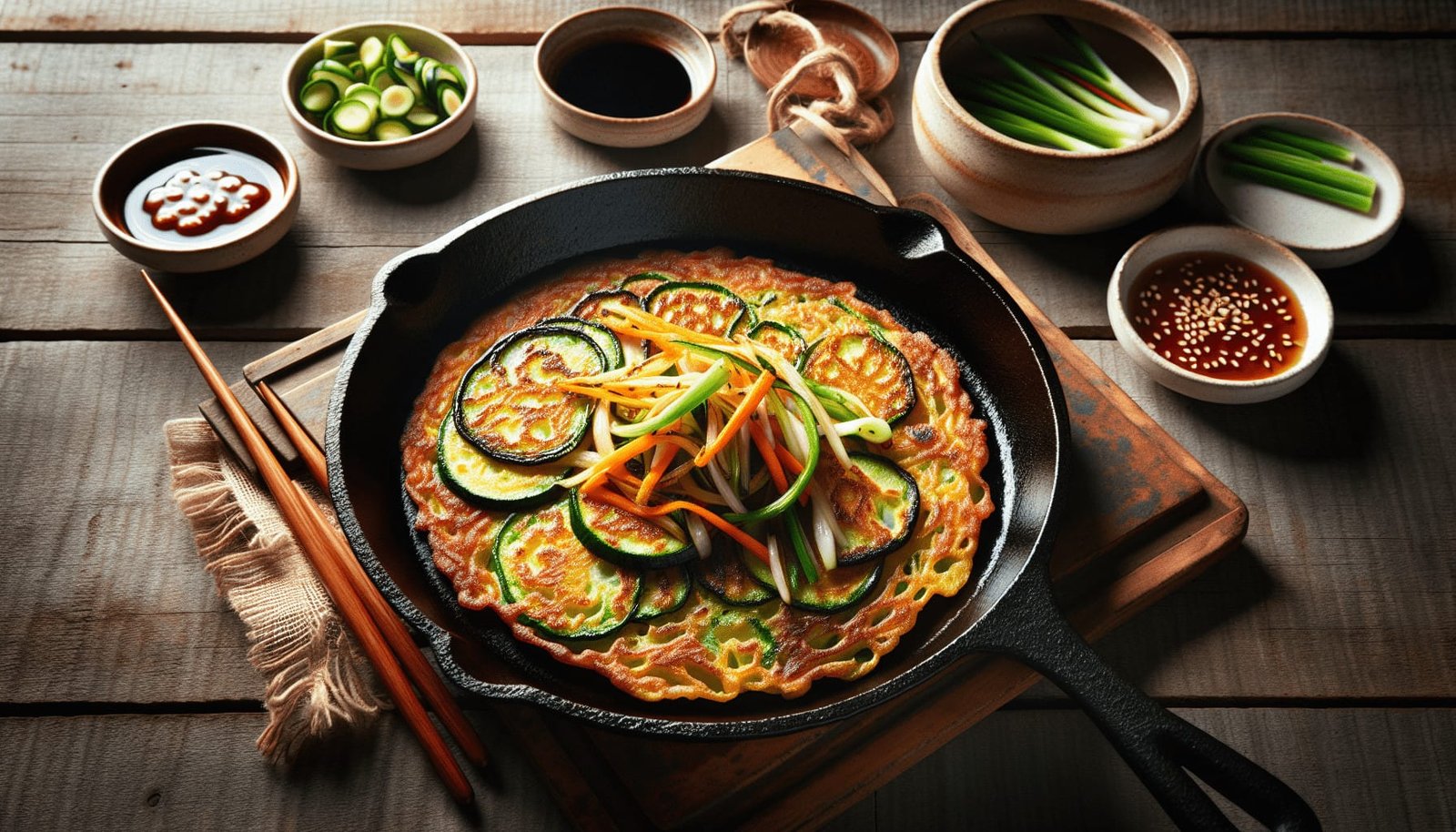Have you ever wondered what makes traditional Korean food so unique and irresistible? One dish that beautifully exemplifies the rich culinary heritage of Korea is the humble yet delicious yachaejeon, or vegetable pancake. With its crispy exterior, savory flavor, and colorful array of vegetables, yachaejeon is a delightful treat that can be enjoyed at any time of the day. Let’s uncover how this traditional Korean dish is made and why it holds such a special place in Korean cuisine.

What is Yachaejeon?
Yachaejeon, often referred to as Korean vegetable pancake, is a popular Korean dish made primarily with fresh vegetables and a simple batter. In Korean, “yachae” means vegetables, while “jeon” refers to a pancake or fritter. This dish is a staple in Korean households and is frequently served as a side dish (banchan) or as an appetizer.
Yachaejeon is prized for its versatility. You can use almost any combination of vegetables, making it a great way to use up leftover produce. The pancake is typically cooked until its edges are crisp and golden, leaving the inside tender and full of flavors.
Ingredients for Yachaejeon
Creating the perfect yachaejeon begins with gathering the right ingredients. The simplicity of the ingredient list is one of this dish’s greatest strengths. Here’s what you’ll need for a basic yachaejeon:
| Ingredient | Quantity | Notes |
|---|---|---|
| All-purpose flour | 1 cup | Acts as the base for the batter |
| Water | 3/4 cup | Adjust for desired batter consistency |
| Eggs | 1-2 | Provides structure and richness |
| Salt | 1/2 teaspoon | Adjust according to taste |
| Assorted vegetables | 2-3 cups | Typically includes onions, carrots, zucchini, and green onions |
| Oil | 2-3 tablespoons | For frying; vegetable or canola oil works well |
Choosing the Vegetables
One of the beauties of yachaejeon is its adaptability when it comes to ingredients. While there are vegetables that are traditionally used, you can pretty much tailor the recipe based on your preferences or what’s available. A typical yachaejeon may include:
- Green Onions: Cut into 2-inch long pieces.
- Carrots: Thinly sliced or julienned for a slight sweetness and vibrant color.
- Zucchini: Sliced into thin strips, adding moisture and texture.
- Onions: Sliced thin for a slight crunch and sweetness.
Feel free to incorporate bell peppers, mushrooms, or even spinach if you’re in the mood to experiment.
How to Make the Batter
Making the batter is a straightforward process. The goal is to create a mixture that holds the vegetables together without becoming too thick or thin. Here’s how you can prepare it:
- Mix Dry Ingredients: In a large mixing bowl, combine the all-purpose flour and salt.
- Add Wet Ingredients: Gradually add the water and whisk until smooth. Then, add the eggs and mix until combined. The batter should have a pourable consistency.
- Combine Vegetables: Gently fold in the prepared vegetables, ensuring they are evenly coated with the batter.
Cooking Yachaejeon
Cooking yachaejeon requires a little patience and practice to achieve that perfect crispy edge. Here’s a guide to help you cook the perfect pancake:
Heat the Pan: Use a non-stick skillet or frying pan. Heat the oil over medium-high heat. It’s crucial that the pan and oil are hot before adding the batter, as this helps create a crispy texture.
Spread the Batter Evenly: Pour a ladleful of the batter into the pan and spread it out evenly, using the back of the ladle to thin it out if necessary. This ensures that the pancake cooks evenly and the edges crisp up nicely.
Cook Until Golden: Let the pancake cook for about 3-4 minutes on one side or until you see the edges turning golden brown. Flip it carefully using a wide spatula, and cook the other side for another 2-3 minutes.
Drain and Serve: Once cooked, remove the pancake and let it drain on a paper towel to absorb excess oil. Slice into wedges and serve hot.
Tips for the Perfect Yachaejeon
- Consistent Heat: Keep the heat at medium-high. If it’s too low, the pancake may become oily.
- Don’t Overcrowd the Pan: If making multiple pancakes, do them one at a time for best results.
- Adjust the Batter: If the batter is too thick, add a little more water. If too thin, add a touch more flour.

The Joy of Dipping Sauces
In Korea, the experience of eating yachaejeon isn’t complete without a flavorful dipping sauce. The basic dipping sauce is made with soy sauce as its base, adding a depth of umami and completing the flavor profile of the pancake. Here is a classic dipping sauce recipe you can try:
Simple Soy Dipping Sauce
| Ingredient | Quantity |
|---|---|
| Soy sauce | 2 tablespoons |
| Vinegar | 1 tablespoon |
| Water | 1 tablespoon |
| Sesame oil | 1 teaspoon |
| Sugar | 1 teaspoon |
| Garlic, minced | 1 clove |
| Green onion, chopped | 1 |
| Red pepper flakes | A pinch |
Instructions:
- Mix all the ingredients in a small bowl until the sugar dissolves.
- Taste and adjust the seasoning as per your preference.
- Serve alongside the yachaejeon.
Variations and Additions
Although the classic vegetable yachaejeon is a favorite, there are numerous variations you might find interesting:
Haemul Pajeon (Seafood Pancake)
A popular variation of yachaejeon is ‘haemul pajeon’, which incorporates seafood. Typically, ingredients like shrimp, squid, or oysters are added to give the pancake an oceanic flavor twist.
Kimchi Jeon (Kimchi Pancake)
For lovers of fermented flavors, adding finely chopped kimchi brings that unique, tangy flavor characteristic of Korean cuisine. The kimchi also adds a vibrant color to the pancake.
Potato Jeon
Some might prefer the addition of shredded potatoes which add a hearty texture to the dish. This variation provides a twist on the traditional and adds a filling component to the pancake.

Enjoying Yachaejeon
Yachaejeon isn’t just about the ingredients and recipes; it’s also about the social experience. Whether you’re enjoying it alone or with friends and family, this dish invites conversation and a shared appreciation for good food.
Pairing with Other Dishes
In Korea, yachaejeon is commonly eaten alongside other small dishes such as kimchi, pickles, and various other banchan. It pairs beautifully with a bowl of warm rice or as a part of a larger Korean meal.
Sharing with Friends and Family
The beauty of yachaejeon lies in its communal nature. It is often cooked and served as a snack for gatherings, and its preparation is a social activity, encouraging shared experiences and memories.
The Cultural Significance of Yachaejeon
In Korea, food is not just sustenance but also a cultural tradition that binds generations. Yachaejeon is more than just a pancake; it signifies thriftiness and creativity, reflecting the Korean principle of hwa-je, which involves harmonizing ingredients for balanced flavors.
Celebrations and Traditions
Yachaejeon is a dish that frequently appears during cultural celebrations and family gatherings. From ancestral rites to festive occasions, it embodies the spirit of hospitality and togetherness.
By understanding the making and enjoyment of yachaejeon, you not only learn a recipe but also explore a piece of Korean heritage that has been cherished and passed down through generations. Now that you know all about this delightful dish, it’s time for you to try making yachaejeon at home and enjoy this crispy, savory pancake, creating your own culinary tradition in the process!

